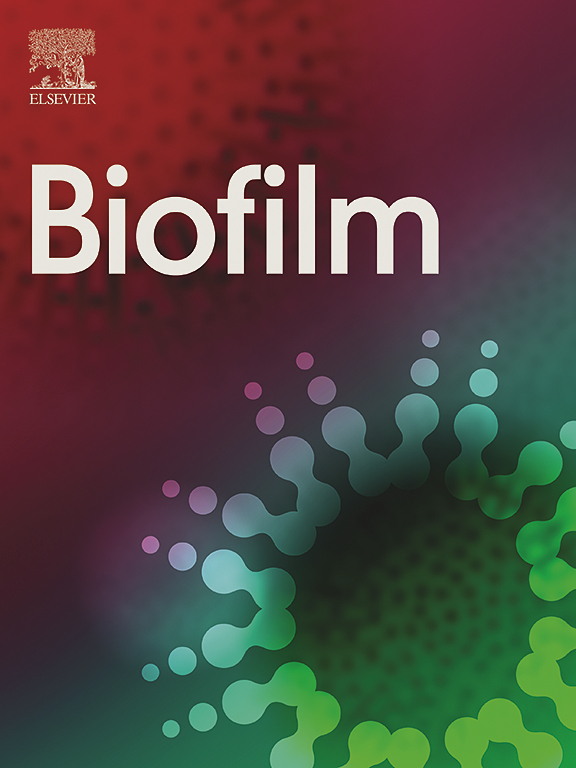Comparative transcriptomics analysis of the Oleidesulfovibrio alaskensis G20 biofilms grown on copper and polycarbonate surfaces
IF 4.9
Q1 MICROBIOLOGY
引用次数: 0
Abstract
Sulfate-reducing bacterial (SRB) biofilms are prevalent across diverse environments, playing key roles in biogeochemical sulfur cycling while also contributing to industrial challenges such as biofouling and biocorrosion. Understanding the genetic and physiological adaptations of SRB biofilms to different surfaces is crucial for developing mitigation strategies. This study presents a comparative transcriptomic analysis of Oleidesulfovibrio alaskensis G20 biofilms grown on copper and polycarbonate surfaces, aimed at elucidating their differential responses at the molecular level. RNA sequencing revealed 1255 differentially expressed genes, with copper-grown biofilms exhibiting upregulation of Dde_1570 (flagellin; log2FC 2.31) and Dde_0831 (polysaccharide chain length determinant; log2FC 1.15), highlighting enhanced motility and extracellular polymeric substance production. Conversely, downregulated genes on copper included Dde_0132 (Cu/Zn efflux transporter; log2FC −3.37) and Dde_0369 (methyl-accepting chemotaxis protein; log2FC −1.19), indicating a metabolic shift and stress adaptation to metal exposure. Morphological analysis via SEM revealed denser biofilm clusters with precipitates on copper, whereas biofilms on polycarbonate were more dispersed. AFM analysis showed a 4.6-fold increase in roughness on copper (44.3 ± 3.1 to 205.89 ± 8.7 nm) and a 3.8-fold increase on polycarbonate (521.12 ± 15.2 to 1975.64 ± 52.6 nm), indicating surface erosion and structural modifications. Protein-protein interaction analysis identified tightly regulated clusters associated with ribosomal synthesis, folate metabolism, and quorum sensing, underscoring their role in biofilm resilience. Additionally, functional annotations of uncharacterized genes revealed potential biofilm regulators, such as Dde_4025 (cytochrome-like protein; log2FC 4.18) and Dde_3288 (DMT superfamily permease; log2FC 3.55). These findings provide mechanistic insights into surface-dependent biofilm formation, with implications for designing antifouling materials and controlling microbial-induced corrosion.
铜和聚碳酸酯表面生长的alaskensioledsulfovibrio G20生物膜的转录组学比较分析
硫酸盐还原细菌(SRB)生物膜在各种环境中普遍存在,在生物地球化学硫循环中发挥关键作用,同时也为生物污染和生物腐蚀等工业挑战做出了贡献。了解SRB生物膜对不同表面的遗传和生理适应性对于制定缓解策略至关重要。本研究对生长在铜和聚碳酸酯表面的alaskensioledesulfovibrio G20生物膜进行了转录组学比较分析,旨在阐明它们在分子水平上的差异反应。RNA测序显示1255个差异表达基因,铜生长的生物膜显示Dde_1570(鞭毛蛋白;log2FC 2.31)和Dde_0831(多糖链长度决定因素;log2FC 1.15),突出了增强的运动性和细胞外聚合物物质的产生。相反,铜上下调的基因包括Dde_0132 (Cu/Zn外排转运蛋白);log2FC−3.37)和Dde_0369(甲基接受趋化蛋白;log2FC−1.19),表明对金属暴露的代谢变化和应激适应。扫描电镜形态学分析表明,铜表面的生物膜簇密度更大,有沉淀,而聚碳酸酯表面的生物膜更分散。AFM分析表明,铜表面粗糙度增加4.6倍(从44.3±3.1到205.89±8.7 nm),聚碳酸酯表面粗糙度增加3.8倍(从521.12±15.2到1975.64±52.6 nm),表明表面侵蚀和结构改变。蛋白质-蛋白质相互作用分析发现了与核糖体合成、叶酸代谢和群体感应相关的紧密调控簇,强调了它们在生物膜弹性中的作用。此外,未表征基因的功能注释揭示了潜在的生物膜调节因子,如Dde_4025(细胞色素样蛋白;log2FC 4.18)和Dde_3288 (DMT超家族渗透酶;log2FC 3.55)。这些发现为表面依赖性生物膜形成提供了机理见解,对设计防污材料和控制微生物引起的腐蚀具有指导意义。
本文章由计算机程序翻译,如有差异,请以英文原文为准。
求助全文
约1分钟内获得全文
求助全文

 求助内容:
求助内容: 应助结果提醒方式:
应助结果提醒方式:


